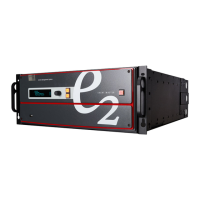3. General
Key Fill
The video which fills the hole cut by the keying circuitry. Typ ically, switchers provide a variety of choices for the fill source — internal
mattes, external video, or "self" fill are several examples.
Key Mask
A key modification system that protects a portion of the foreground video from being keyed, using the switcher’s internal pattern
system .
Key Signal
Also kn o w n as Key Source. The signal that electronically cuts the hole in the background video signal. Ke
y signals typically originate
from external inputs such as character generators or cameras.
Layer
An image d isplay element (such as a P IP, Key or Background) that has an as soc iated visual priority — either in front (or in back) of
another layer.
Linear Key
Linear key is a keying mode in which the edges of anti-aliased key sources (such as character generators) a re reproduced clearly.
Typically, two separate signals are required from a linear key source: a cut and a fill.
Menu
A te rm used to describe buttons and functions on the high-resolution color LCD touch screen.
Mix
Also known as a Dissolve. A transition between two video sources in wh ich one source fades out as the other fades in.
Mixer
Circuitry that enables you to transition (and scale) PIPs and Keys over a background.
Multiviewer (MVR)
MVR is a monitoring system that enables m ultiple sources (input and outputs) to be displayed on one or more m onitors, eliminating
the n eed for individual source m onitors. By utilizing different arrays of PIPs, us ers can select the preferred multiviewer “look,” and
streamline their workflow.
NTSC
National Television Standards Com mittee. The oldest standard for color picture broadcasting. NTSC is a standard defin ition format
that operates at a frequency of 60Hz , with 525 lines, 60 fields and 30 frames per second.
PAL
Phase A lternating L ine. PAL is the NTSC equivalent TV standard in Europe. PAL is a standard definition format that operates at a
frequency of 50Hz, with 625 lines, 50 fields, and 25 frames per second.
PGM (Program)
The s witcher ’s main output signal.
PIP
Picture-in-Picture, an on-screen c onfiguration in which one picture (typically of reduced size) is positioned over ano ther background
image — or another PIP. PIPs can be r educed, enlarged, bordered, shad owed, and mixed on and off Program. PIPs can overlap
each othe r, depending on their visual priority. In E 2, the multiviewer PIPs are not allowed to overlap.
Preset
Storage register in w hich you can store (and recall) the entire con figuration or “look” of your destination(s).
PRVW (Preview)
The video that will appear next on program
(main) outputs.
RGB
The red, green and blue color s ignal components.
RGBHV
Defines a connection scheme w ith five lines: one for red, one for green, one for blue, one for the horizontal sync and one for the
vertical sync. This is the standard used in VGA and other analog P C com puter monitors.
R5905948 E2 12/12/2014
19

